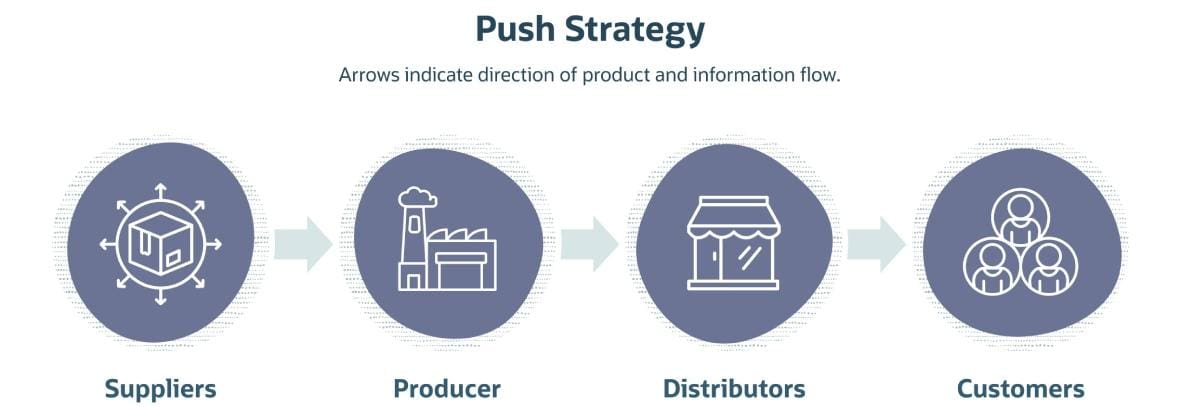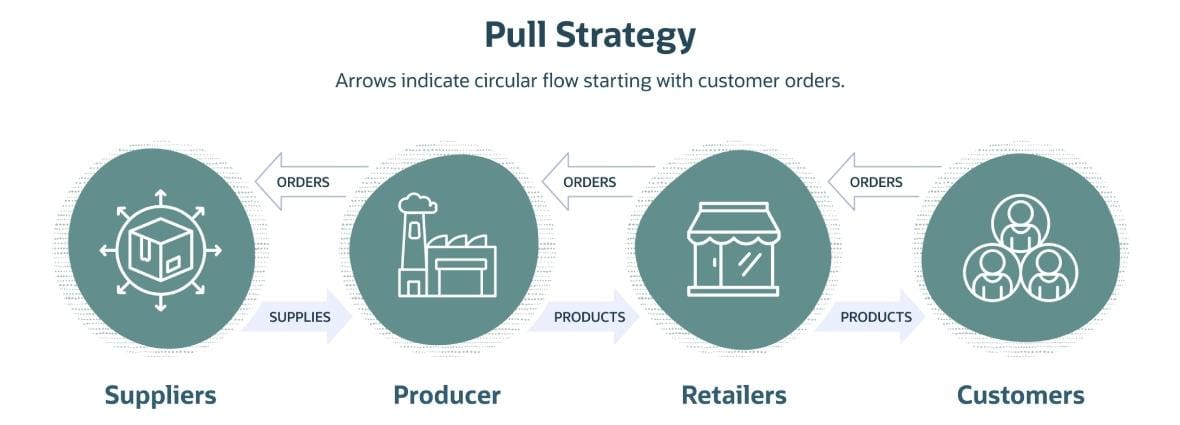“Any customer can have a car painted any color that he wants so long as it is black,” Henry Ford, founder of the Ford Motor Company, famously wrote in his autobiography. Nowadays, customers expect much more choice — but each additional option creates added dilemmas for businesses. For some businesses, producing standardized products and “pushing” them to customers is efficient and profitable (it worked for Ford’s Model T). But for others, responding quickly and effectively to customer demand is the source of success. The first of these is a “push” strategy and the second is known as “pull.”
Finding the right balance between push and pull strategies is crucial for businesses to optimize their supply chain efficiency, minimize costs and keep customers satisfied. This article explains how push and pull strategies work and how businesses can choose the best solution to fit their needs, including hybrids of both.
What Is a Push System?
As its name suggests, in a push system the business produces a set quantity of standard products, then “pushes” them to customers. Typically, the business estimates the quantity of products that customers are likely to want, produces that amount up front, then gradually sells down the stock. Push systems, therefore, involve holding inventory. Simple examples of a push system might be an artist who builds up a stock of finished paintings, then displays them for sale in gallery exhibitions; and a manufacturer that makes wireless speakers and distributes them through retail electronics stores. “Just-in-case” inventory strategy, where manufacturers hold excess stock of finished products to ensure that they can always respond to customer demand, works hand in glove with push systems.
What Is a Pull System?
A business that uses a pull system produces products in response to specific customer demand. When a customer places an order, this triggers an instruction to produce the product. Customer orders, therefore, can be said to “pull” products from the business. In a pure pull system, finished goods inventory is not held in stock, since products are made to order and work in progress is limited to products for which there is an outstanding order. An artist producing commissioned works to order is a simple example of a pull system. In its early days, during the 1980s, Dell Technologies differentiated itself from other PC makers by building computers to order. “Just-in-time” inventory strategy, where manufacturers hold no inventory and obtain parts and raw materials as needed to fulfill customer orders, is also a type of pull system.
Key Takeaways
- In a push strategy, businesses forecast customer demand and build up inventory in anticipation of customer orders.
- In a pull strategy, businesses respond to customer demand by producing products in response to customer orders.
- Push strategies often work well when customer demand is stable and products are standardized, have long production times and a short shelf life.
- Pull strategies often work well when customer demand is volatile or products are highly tailored or bespoke.
- Many companies use a combination of push and pull strategies.
Push vs. Pull Strategies Explained
Push and pull strategies fundamentally affect the way companies interact with customers and suppliers.
In a push system, the company forecasts how much product it can sell in a given time period, obtains parts and raw materials from its suppliers, produces all of the product in a single production run, then pushes it to customers. Some companies sell directly to buyers while others sell via intermediaries, such as dealerships and retail outlets. Companies using push strategies don’t wait for customer demand before doing their production run. Instead, they use sophisticated demand forecasting and/or plot how to generate customer demand. For example, retail clothing shops start to stock warm clothes and push them to customers toward the end of the summer, rather than waiting for demand to rise when colder weather arrives.
It’s important that the product sells as quickly as possible in a push system because the company is holding inventory, which adds cost, and the product can become obsolete. For example, in the retail clothing market, products can become obsolete in as little as six months, so push system advertising tends to emphasize haste and may suggest imminent shortages — such as, “These products are going fast! Buy now to avoid disappointment!” Early bird discounts are often part of a push strategy: “Buy now before prices rise!” However, companies typically don’t sell all their inventory at the premium price, so end-of-line and seasonal sales with heavy discounts are another feature of push strategies.
Obviously, a push strategy doesn’t fit well with an individually customized or bespoke quality product. In retail clothing, manufacturers that produce clothing for the mass market typically use a push strategy, but tailors who make quality suits to order are apt to use a pull strategy.
In a pull system, when a company receives an order, it obtains sufficient raw materials and intermediate parts to produce just the amount of product ordered. These companies prefer to have a constant flow of orders so that production runs continuously, rather than stopping and starting. Many companies also aim to time deliveries from suppliers for just-in-time production, so there is little to no delay between receiving supplies and commencing production. However, to shorten lead times and self-insure against delivery failures, some companies prefer to maintain buffer stocks of essential supplies. For example, a bespoke tailor may keep popular fabrics in stock.
Businesses using a pull strategy raise awareness of their products through advertising and promotions, just as those using a push strategy do. But their advertising tends to be less focused on time and price and more on the quality and uniqueness of the product. Companies using a pull system tend not to offer early bird, end-of-line or seasonal bargains, since they don’t need to sell products quickly or unload excess inventory — but they may offer discounts to help build customer relationships and gain repeat sales.
Many businesses find that a combination of the two works best for their specific needs. The optimal balance depends on factors such as product type, market demand, production lead times and inventory costs. Understanding these factors is key to developing a supply chain strategy that maximizes efficiency and profitability.
Push vs. Pull Strategies Compared
The top-level distinction between push and pull — that a push system anticipates customer demand and a pull system reacts to it — ripples through businesses that operate on one or the other. Push systems work well for businesses with stable customer demand, reliable historical sales information, long production times and economies of scale. Pull systems tend to work for businesses that have volatile customer demand, little or no historic sales information, short production times and few if any economies of scale. The accompanying table details the key differences in push versus pull systems along 10 key dimensions.
Comparing Push vs. Pull Strategies
| Push Strategy | Pull Strategy | |
|---|---|---|
| Focus | Forecast customer demand | Respond to customer demand |
| Inventory Management | Build inventory in anticipation of Management customer demand. | Keep inventory low, producing product only in response to customer orders. |
| Production Planning | Production levels are set in advance and are constant. | Production is flexible, reacting to specific customer requests. |
| Supply Chain Length | Typically long, often with multiple Length stages of distribution. | shorter and more direct, often with a focus on reducing steps. |
| Cost Implementation | Risk of overproduction and higher storage costs. | Risk of stockouts and potentially higher unit production costs. |
| Risk level | Higher Risk of excess inventory and obsolenscence. | Higher risk of being unable to meet sudden spikes in demand. |
| Efficiency | Efficient in stable environments with predicatable demand. | Effient in volatile markets or when product variety is high. |
| Examples | Consumer staples, mass-produced goods | Custom products, just-in-time manufacturing, high-tech items. |
| Technological Needs | Less reliant on real-time data, more on forecasts and historical data. | Heavilly reliant on real-time data and technology in order to quickly respond to demand. |
| Market Suitability | Best for markets with stable demand and long product life cycles. | Best for markets with fluctuating demand and short product life cycles. |
As the comparison table illustrates, push and pull strategies each have their own strengths and limitations. In practice, most businesses find that a balanced approach, incorporating elements of both, is the most effective way to manage their supply chain. The key is to identify the right mix of push and pull based on the unique characteristics of your products, markets and operations.
Understanding Push Strategy
In a push strategy, products are pushed through the supply chain to end customers in anticipation of customer demand. As a result, information and goods both flow in the same direction: from suppliers to producer, and then from producer to the customer (often via distributors).

Advantages of Push Strategy
A push strategy is great for large-scale production in fast-moving consumer markets and can be a wise choice under other circumstances, too. These are some of the advantages of push strategy:
- Standardization of products that can lead to greater production efficiency.
- Reduced lead time for delivery to customers.
- Economies of scale that reduce the marginal cost of producing a large quantity of product in a single run and that are significantly lower than producing similar product volume in smaller batches.
- Motivation to innovate, so companies can push new products to customers at scale, rather than simply responding to customer demand for existing products.
- Raising resilience in certain circumstances, because holding inventory enables companies to continue selling through supply chain disruptions.
- Prices that can be fixed along the supply chain to improve cash flow and minimize price volatility for customers.
Limitations of Push Strategy
Advantageous, yes, but a push strategy can also leave a company unable to respond to changes in customer demand, resulting in high costs and dissatisfied customers. Some other limitations of push strategy include:
- Products that cannot be tailored to meet individual customer needs.
- Risk of stockouts or overproduction if demand forecasts are wrong.
- The cost and risk of holding inventory.
- Products that may become obsolete before they can be sold, particularly in fast-changing markets, forcing companies to discount heavily to unload stock.
- Reliance on accurate demand forecasting, prompting the need for good data on historical sales, manufacturing, inventory and supply chains.
Real-World Examples of Push Strategy
Companies in fast-moving consumer goods markets typically prefer push strategies. For example:
- Coca-Cola and PepsiCo partner with distributors and retail outlets to ensure that their products are always available in stores and vending machines. Both companies also lean on advertising and promotions to raise brand awareness.
- Procter & Gamble works with wholesalers and distributors to push its products onto store shelves. It is also a major advertiser and offers incentives to retailers to promote its products.
- Nestlé partners with retailers to make sure its products are always available to customers. It uses advertising and promotion to create demand.
Understanding Pull Strategy
In a pull strategy, production responds to customer demand. Customer orders are fed back to producers, and products are shipped in response. Thus, there is a circular flow: Customer orders trigger orders to producers and from producers to suppliers; supplies flow from suppliers to producers; then products flow from producers to customers. There may also be some flows in the opposite direction, if customers return unwanted products to producers and producers issue refunds.

Advantages of Pull Strategy
The main characteristics of a pull strategy are flexibility and responsiveness. In sophisticated markets, these qualities can bestow significant advantages over more rigid competitors, including:
- Products that can be tailored to meet the needs of individual customers, resulting in better customer satisfaction.
- Opportunities to charge for add-ons.
- No risk of stockouts or overproduction.
- Low or no inventory costs.
- Companies’ ability to respond dynamically to changing customer needs and preferences.
- Better quality control, as products can be individually checked.
- Efficient allocation of resources.
Limitations of Pull Strategy
Still, the same flexibility and responsiveness that bear such advantages can also result in the company becoming overly influenced by external factors and unable to control costs or plan effectively. Consider these limitations:
- Uncertainty can loom around production planning, because it’s hard to predict when orders will arrive.
- As only a small quantity of product is produced in every run, the marginal cost of production can be high.
- Inaccurate or misinterpreted sales information can falsely amplify demand farther up the supply chain, resulting in excess production and waste. (This is known as the “bullwhip effect.”)
- The company may be exposed to frequent supplier price changes, making it difficult to price products in advance.
- Risks increase due to supply chain disruptions and transportation.
Real-World Examples of Pull Strategy
Companies operating under pull strategies tend to offer bespoke or highly customizable products. Here are two examples.
- Toyota embraces a just-in-time manufacturing strategy. It produces vehicles in response to customer orders, and it orders parts and other supplies only when they are needed.
- Vistaprint advertises bespoke business cards, leaflets and other products online and through social media, and produces them in response to customer orders.
Combining Push and Pull Strategies: Hybrid Strategy
Many businesses have discovered that combining the two approaches can lead to a more agile, efficient and resilient supply chain. Combining push and pull strategies can make companies more responsive to customer needs, as they continue to retain the economies of scale and resilience that stem from mass production. Let’s explore some common combinations of push and pull strategies.
- Push-pull, or “semi-push”: The company responds to customer demand instead of “pushing” products to customers with advertising and promotions, but it fulfills customer orders from inventory, rather than building products in response to customer orders. Inventory gradually runs down until the end of a fixed time period, at which time the company replenishes it.
- Pull-push, or “semi-pull”: Again, the company responds to customer demand, rather than pushing products to customers. When a customer places an order, the company fulfills it from inventory, then immediately initiates a small production run to replenish the inventory.
- Hybrid: The company produces the bulk of its products following a predetermined schedule in accordance with forecasted demand (“push”), but it also does one-off production runs to respond to unforeseen demand spikes (“pull”).
- Push and pull: The company mass-produces components and stores them as inventory, but final assembly is done in response to customer orders.
Supply chains are almost always a mixture of push and pull, depending on the strategies of the individual companies within the chain and the relationships between them. The point at which the supply chain switches from push to pull, or vice versa, is known as the “push-pull boundary” or the “customer order decoupling point.”
Technology companies, such as Apple, and online marketplaces, such as Amazon.com, combine push and pull strategies.
- Apple advertises its products directly to customers to create excitement and generate demand. But it also promotes them through distributors and works with retailers to ensure that its products are always in stock.
- Amazon uses a push strategy for products held in its own warehouses and a pull strategy for products supplied by third parties.
How to Choose: Push vs. Pull vs. Hybrid Strategies
The decision to adopt a push or pull strategy — or a mixture of both — affects the entire business, so it’s crucial to choose wisely. Of all the considerations underlying that choice, the nature of the product itself may be the most crucial factor. Standardized products with longer shelf lives may be better suited to a push strategy, while customized or perishable goods may require a pull approach. Customer demand volatility and predictability also play significant roles — stable and predictable demand favors push, while fluctuating and hard-to-predict demand may necessitate pull.
Production lead times, the ease of starting and stopping production and the potential cost savings from larger, less frequent production runs should also be taken into account. The cost of maintaining inventory is another important factor, as high inventory costs are part of the deal with push strategies. The availability and quality of historical sales data can influence the choice of strategy, as reliable demand forecasts are essential for a successful push approach. Other considerations include the business’s suppliers’ and distributors’ strategies and the reliability of its transportation and distribution networks.
Finally, businesses must weigh the potential costs of supply chain disruptions or of failing to respond quickly to customer needs. A pull strategy may offer greater resilience in the face of such unexpected challenges.
By carefully evaluating these factors, businesses can choose the supply chain strategy that best aligns with their unique circumstances and goals.
Implementing Push and Pull Strategies in Supply Chain Management
Whatever strategy you adopt, it’s important to plan the execution carefully. There are major differences in the steps necessary to implement a push versus a pull strategy. Let’s discuss both at a high level, beginning with the key steps to take when implementing a push strategy.
- Plan demand. Use historical sales data, market and customer data, predictive tools and analytics to forecast demand for products and establish volatility in their demand planning, including any seasonal or repeating patterns.
- Plan inventory. Using the demand forecasts, apply an inventory strategy that calculates the amount of inventory stock needed to meet anticipated demand. Consider what size buffer is necessary to accommodate demand volatility. Provide sufficient warehouse space to hold all of the inventory and consider where and how various inventory items can best be held.
- Schedule production. Use production capacity and resource estimates to determine the level of production needed to create the inventory, as well as how long a lead time is required.
- Engage with distributors and retailers. Ensure that retailers and distributors are ready to accept and promote your products once the production run is complete. Draw up advertising and promotion plans.
- Monitor and adjust. Review and update forecasts regularly and respond quickly to changes in demand to reduce the risk of stockouts and waste. If necessary, plan end-of-line and end-of-season sales.
For a pull strategy, the key steps are:
- Implement real-time data collection systems. These may include point-of-sale systems, online traffic analytics and customer feedback surveys. Pull systems respond to customer demand, so it’s vital that the company always has up-to-date information on how sales are progressing and how customers feel about the products and services.
- Engage with suppliers. For a pull system to work smoothly, suppliers must be ready to respond quickly and efficiently to orders. Constant communication with suppliers is vital if the company is to avoid holding stocks of raw materials and intermediate parts, so consider setting up real-time communications with suppliers.
- Adopt a just-in-time production strategy. Set up processes to ensure that receipt of a customer’s order triggers orders to relevant suppliers, as well as a production run as soon as the supplies are delivered. These processes can be automated.
- Plan advertising and promotion. The aim is to raise awareness of the brand and the products among actual and potential customers to be sure that customer demand spurs retailers to stock the products. Consider online and social media advertising, billboards, and promotions through magazines and TV shows.
Manage Your Strategy With NetSuite’s Unified ERP Software
Whether you are using a push strategy, a pull strategy or some hybrid of the two, having the right technology is crucial for meeting customer needs, keeping costs down and balancing supply and demand. NetSuite’s cloud-based Enterprise Resource Planning (ERP) system integrates order processing, inventory management, production, supply chain and warehouse operations in a single suite of applications. Real-time information at the touch of a button gives businesses complete visibility into their operations, enabling them to maintain lean, efficient processes while remaining agile and resilient in the aftermath of supply chain shocks.
Push strategies are proactive, generating demand by pushing products to customers via intermediaries. Pull strategies are reactive, using advertising and promotions to raise awareness of products among potential customers, then producing the products in response to customer demand. Both strategies have a place in today’s complex markets: Push strategies work well for companies selling standardized products in a fast-moving consumer goods marketplace, while pull strategies are better suited for companies selling products with a degree of tailoring or individuality. In practice, most companies opt for some combination of the two strategies. But central to the success of either strategy is excellent inventory control, supply chain management and customer service.
Push and Pull Strategy FAQs
What is the difference between a push and a pull strategy?
A push strategy forecasts customer demand, produces products to meet the forecasted demand, then “pushes” the products to customers through intermediaries. A pull strategy uses advertising and promotion to create awareness and generate customer demand, then produces products in response to that demand.
When should businesses consider a hybrid strategy?
Adopting a hybrid push-pull strategy can work well when a company has economies of scale but volatile customer demand. In practice, most businesses adopt some kind of hybrid approach.
How does demand variability affect the choice between push and pull strategies?
Push strategies can work well when customer demand is stable and any variations are predictable (such as seasonal patterns). But if customer demand is unknown (for example, if the product is completely new) or is prone to unpredictable swings, a pull strategy might be the better choice.
What role does technology play in choosing between push vs. pull strategy?
Push and pull strategies both rely on technology, but the technology that each strategy needs is different. Push strategies call for sophisticated technology to collect and analyze historical data and produce accurate and reliable demand forecasts. Pull strategies need fast, responsive, real-time data analytics and communications. The type of technology available to the company may, therefore, be a critical factor in determining which strategy to adopt.
What is a push-pull strategy example?
Designer clothing companies often use push-pull strategies. They advertise clothes that are sold directly to customers, rather than selling them through mass market retailers, and they may offer a tailoring service. But they typically create inventory at the start of each season and sell it down over the course of the season, replenishing it at the start of the next season.
What is an example of a push and pull system?
The computer manufacturer Dell uses a push and pull system. It maintains an inventory of component parts, which it assembles into finished products on receipt of customer orders.









